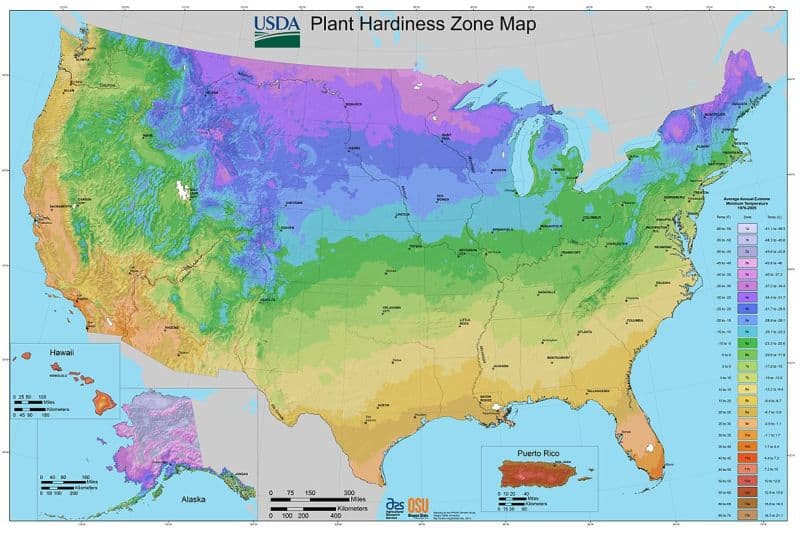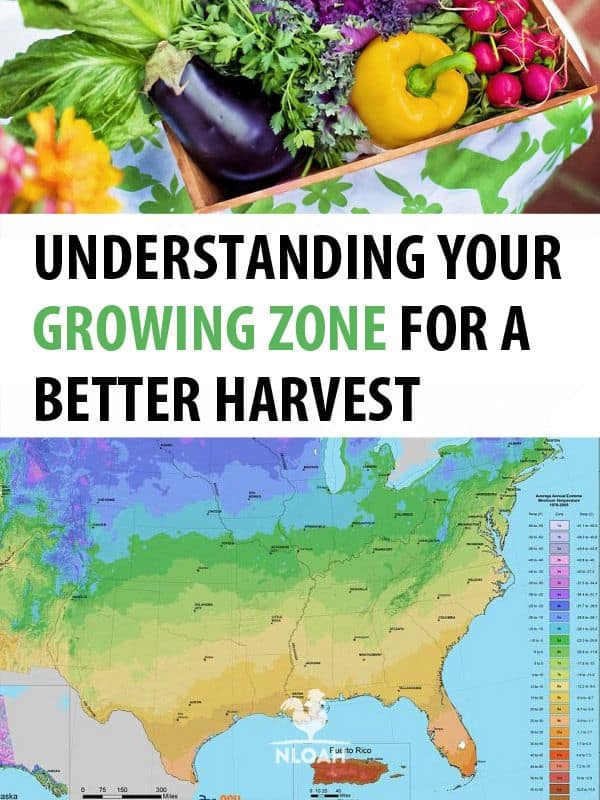There are so many things to consider when establishing a homestead: from deciding what kind of animals to raise to what you should grow in the garden. Many new homesteaders may be overwhelmed with the amount of land that gardening looks like a simple task. However, gardening on such a big scale in order to feed your family will be quite the undertaking.
You will have to take into account many different factors when planning your garden as well as take into consideration the particular location of your homestead. Here are some ways that you can reap a better harvest once you learn more about your specific growing zone.
Know Your Zone
The first step to planting a garden that will do well is to know what USDA Plant Hardiness Zone your homestead is located. The hardiness zones are the standard by which fellow homesteaders and gardeners use to see what plants are most likely to thrive in their area.
The zones are determined by their average minimum winter temperature on an annual basis. So, if you live in the Northern United States you will most likely have a lower USDA zone number than if you lived in the Southern part of the country.
Each Zone and the Annual Average Extreme Minimum Temperature (from 1976-2005; in Fahrenheit):
- 1a: -60 to -55
- 1b: -55 to -50
- 2a: -50 to -45
- 2b: -45 to -40
- 3a: -40 to -35
- 3b: -35 to -30
- 4a: -30 to -25
- 4b: -25 to -20
- 5a: -20 to -15
- 5b: -15 to -10
- 6a: -10 to -5
- 6b: -5 to 0
- 7a: 0 to 5
- 7b: 5 to 10
- 8a: 10 to 15
- 8b: 15 to 20
- 9a: 20 to 25
- 9b: 25 to 30
- 10a: 30 to 35
- 10b: 35 to 40
- 11a: 40 to 45
- 11b: 45 to 50
- 12a: 50 to 55
- 12b: 55 to 60
- 13a: 60 to 65
- 13b: 65 to 70
This information is based on the USDA Plant Hardiness Zone Map (2012).
See the map below:

However, these zones are not straight lines as they follow winter temperatures. Places in Colorado and even parts of Northern New Mexico have surprisingly different zones than other states along the same latitude. There are also many instances where a small area of a lower zone is completely surrounded by a higher zone due to altitude and microclimates.
The zones are numbered from 1-13 and each number is divided up into two different parts. For example, you could be in Chicago in Zone 5b while neighbors to the North in Wisconsin are in zone 5a. Each determination depends on the average lowest winter temperature. You can check online for specific information if you are near in between zones as well.
Know Your Zone
You may notice that a wide variety of plants have information about them that state that they are good for a wide range of zones.
For example, a hydrangea is listed as being able to grow in Zones 3-9 which is a wide range of winter temperatures. Zone 3a has an average winter minimum of -40°F while Zone 9b has an average winter minimum of 30°F. A lot can happen in that 70 degree difference! The USDA Zones are just a recommendation and are not a guarantee that a plant will do well in your garden.

Gardeners in Zone 3 may think twice about planting hydrangeas if they think the winter will be unusually cold. Living in Zone 5 or 6, the middle of the spectrum, gardeners have more variety with northwestern coast plants that can fulfill a natural forest like landscape and sustain through different seasons.
Whereas gardeners in Zone 10 may want to consider planting a different variety that loves hot weather like succulents. If your zone is listed on either end of the plant’s recommended growing zone it is a good idea to carefully consider the chances that the plant may have a hard time growing or even die due to the extreme conditions.
Know Your Specific Weather
A successful homesteader that plants their garden based on the hardiness zones knows their weather. They take notes on when the last frost was last year in order to be prepared for planting this year. A homesteader should pay close attention to seasons and any unusual conditions. Common changes in weather patterns include:
- High and low seasonal temperature changes
- Precipitation, such as rain
- Heavy precipitation, including heavy rain, thunderstorms, and flooding
- Tropical storm weather, including heavy winds and heavy precipitation
- Snow, sleet, and hail
- Drought
These conditions in your area play an essential role to your garden and how well your plants will produce. Make sure that you know the normal weather for your specific location and compare that to past years of how plants did in your garden. No two years can be the same but knowing the difference will help you tailor the care of your plants in order to reap a better harvest.
Know Your Frost Dates
Each USDA Hardiness Zone also comes with the average first and last frost dates of the year. This information is important in planning a successful garden. Note the last frost date of the spring and count how many days went by before the first frost date of the fall. The difference of days is your growing season.
Lower zones will have much shorter growing seasons (Zone 1 has just 90 days!) while higher zones will have much longer growing seasons that can last year round. Knowing your frost dates will help you determine what seeds can be planted in the ground and what seeds need to be started indoors in order to give them enough time to develop and mature for harvest.
Know Your Cool and Warm Season Plants
Did you know that vegetables are either a cool or warm season plant? Many new homesteaders may not realize that there is a difference in vegetables according to the conditions of the garden.
Cool season vegetables, those that grow best in cooler conditions, include peas, green beans, lettuce, carrots, broccoli and cauliflower. These plants should be started early and then transferred to a garden if your growing zone is of short or average length.
Once the summer sun hits the garden these plants will either die or flower as they near the end of their growing season.
Warm season vegetables, those that grow best in warm conditions, love the hot sun and can’t get enough of summer weather. Some examples of warm season vegetables include cucumbers, tomatoes, zucchini, watermelons, potatoes and peppers. Usually these seeds can be started right in the garden if your growing season is of average length.
Make sure to plan ahead with some of the warm season vegetables that need a lot of time to develop though. These plants would include watermelons, cantaloupe, and pumpkins as they need extra time in the garden to grow such large produce.
Make sure that you still pay attention to cold and warm season plants if you live in a higher zone with almost a year round growing season. Just because it is sunny and mild in the winter doesn’t mean that a warm season vegetable will grow. In fact, most cold season vegetables do better in higher zones as more of the year is in that cooler growing season temperature range.
Know Your Plan
Taking the time out to plan your garden is probably the most important part of growing produce for a great harvest. There are so many different conditions in a garden that many new homesteaders may not be aware of. Many of these lessons will be learned through trial and error over a couple years of time as well.
Start planning your garden for the spring months before you can actually start tilling the soil. Make a list of the cool weather plants that you want to start with and check to see if you will need to start those plants indoors in order to take advantage of your particular growing season.
Decide which plants you want to have in your garden this year, both cool and warm season varieties, and order the seeds that you need. Ordering seeds early is another essential part of planning your garden so that you don’t run out of time to start seeds indoors.
Once you have you a list of what you want to plant, as well as the seed packets in hand, check the information on the back of the seed packet. You will find a wealth of details about the particular seed that you purchased as well as the growing recommendations. Don’t assume that every bean is the same but make sure to check the growing information that has been provided.
Roughly sketch out your garden either on the computer or with paper and pencil. Note how much produce will be harvested from one plant as well as spacing recommendations.
Plan where you will be planting each seed or plant in your garden and make sure to leave room for adequate walkways! Almost no garden is completely level so make sure to take into account areas of the garden that are moister than others.
Homesteaders should plan to plant moisture loving plants in that area in order to use the natural environment to reap a better harvest. The same is true if there are drier parts of the garden or perhaps shaded areas. You should also plan to plant varieties that can handle those specific conditions and still produce an ample amount of produce.
Know Your Temperatures
Once your garden is planted make sure to keep an eye on nightly temperatures in case there is a dip in the forecast. Just because the average last frost has gone by doesn’t mean that there can’t be a variation during the few weeks after planting.
Cover those plants prone to frost with plastic sheeting in order to keep them warmer on a cold night. It would be horrible to lose a plant to frost that you started indoors and spent so much time growing. Make sure to check the weather daily in order to protect your plants at the start and end of the growing season.
Know Your Garden Specifics
As your garden grows take note of things that are happening. If there was a big rain storm that drowned your beans consider replanting them in a hill formation in order to keep them drier.
If you noticed an insect that ate through lettuce make sure to use natural insect repellent in order to save future produce as well as consider making a change for next year. Keeping an eye on your garden will help you learn about your specific homestead and how to change things for future years.
Knowing your growing zone is just the start of being able to grow more produce for a better harvest. Temperatures, climate, and past weather trends play a huge role in how well your garden will do from year to year.
New homesteaders shouldn’t get discouraged if something didn’t quite turn out like you had planned. Talk with others in your area and learn different tips and tricks that are used in order to encourage a bountiful harvest. Understand your growing zone and the growing season in your specific area to have a better harvest this year.

Kristina Phelan is a freelance writer and her parenting column, Mama Bear Moxie, is printed in a few newspapers across the country. She lives on a farm in the Midwest with her husband, three kiddos, and too many animals.
I’ve taken over this blog from Kendra Lynne around 2018, and turned it into one of the best an most comprehensive homesteading website out there. I was raised partly in the countryside living a very frugal life ever since I can remember.
